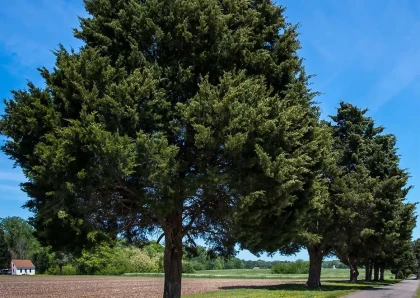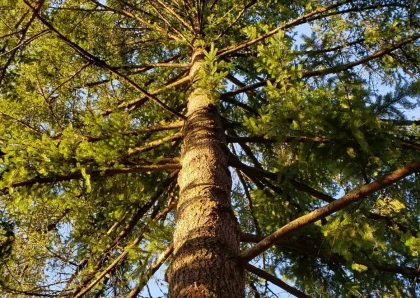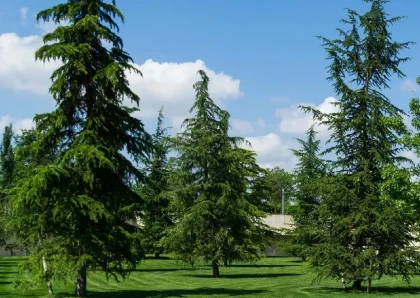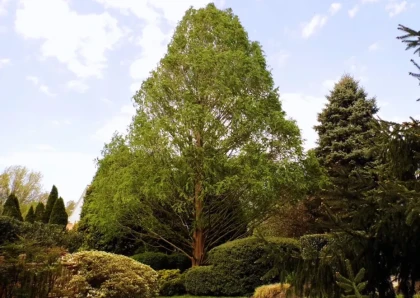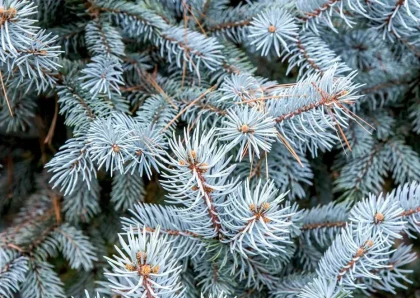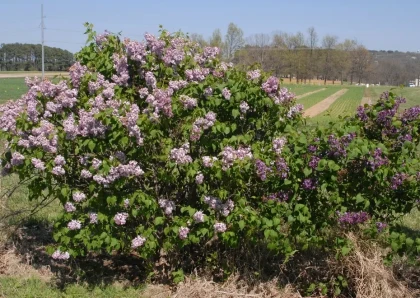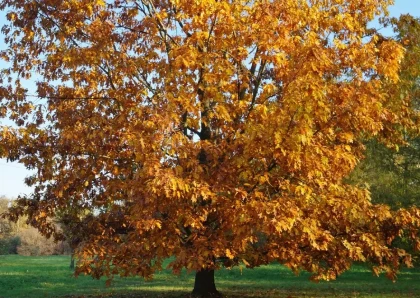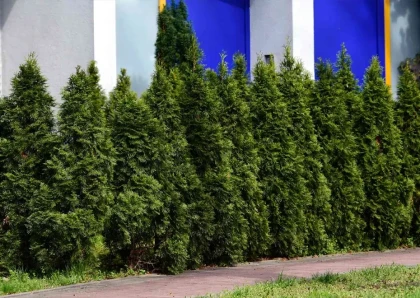
Eastern White Pine Tree
Overview
The Eastern White Pine (Pinus strobus) is a large, evergreen coniferous tree native to eastern North America, including the United States and Canada. It is one of the most important and valuable timber trees in the region. The Eastern White Pine is also the state tree of Maine and Michigan.
Key Features:
- Appearance: The Eastern White Pine typically has a straight, tall trunk that can reach heights of 50 to 80 feet (15 to 24 meters) or more. In ideal conditions, some specimens can even exceed 100 feet (30 meters) in height. The tree has a conical shape, with horizontal branches that sweep upwards.
- Needles: The Eastern White Pine has soft, flexible needles that are bluish-green in color and usually occur in bundles of five. Each needle is approximately 2.5 to 5 inches (6 to 12 centimeters) long.
- Cones: The tree produces cones that are cylindrical in shape and can be 4 to 8 inches (10 to 20 centimeters) long. These cones shed their seeds and often remain on the tree for an extended period.
- Habitat: Eastern White Pines thrive in a variety of habitats, including moist, well-drained soils, and they are commonly found in mixed forests alongside other coniferous and deciduous tree species.
- Historical significance: Eastern White Pines played a significant role in American history. The British Navy used these trees for ship masts due to their impressive height and straightness, leading to a series of laws and disputes known as the "Pine Tree Riot" and "Mast Tree Act" in colonial New England.
- Economic importance: The Eastern White Pine has been extensively used for lumber and other wood products due to its straight grain, lightweight nature, and ease of working with hand tools and machinery. As a result, it has been a valuable natural resource for construction, furniture-making, and various other applications.
- Fastigiate Eastern White Pine: Some Eastern White Pines have a more columnar or upright growth habit, known as fastigiate forms. These trees have branches that grow more vertically, creating a narrow, tall appearance.
- Dwarf Eastern White Pine: Occasionally, you may find dwarf or compact varieties of Eastern White Pine. These are smaller versions of the species, with slower growth rates and shorter overall heights.
- Cultivated Varieties: In horticulture and landscaping, there may be cultivated varieties or cultivars of Eastern White Pine with specific traits like unique needle colors, growth patterns, or disease resistance. These cultivated varieties are usually created through selective breeding.
- Air Purification: Eastern White Pine trees, like all other trees, play a crucial role in absorbing carbon dioxide and releasing oxygen, helping to improve air quality.
- Stormwater Management: The extensive root systems of Eastern White Pine trees help prevent soil erosion and control stormwater runoff, reducing the risk of flooding and soil degradation.
- Habitat for Wildlife: The dense foliage and large size of Eastern White Pine provide excellent habitat and shelter for various wildlife species, including birds, squirrels, and other small mammals.
- Timber Production: Eastern White Pine is a valuable timber tree, commonly used in the construction industry for lumber, interior finishing, and other wood products.
- Furniture Manufacturing: The wood's fine texture and workability make it a popular choice for furniture production.
- Decorative Items: Eastern White Pine is used to create decorative items, wooden crafts, and carvings.
- Paper and Pulp Industry: The tree's long fibers make it suitable for the production of paper and pulp.
- Scenic Beauty: Eastern White Pine forests contribute to the aesthetic beauty of landscapes, particularly in natural and park settings.
- Recreational Activities: These forests provide opportunities for recreational activities such as hiking, camping, birdwatching, and nature appreciation.
The Eastern White Pine (Pinus strobus)
The Eastern White Pine is a single species, and there are no different "types" of Eastern White Pine in terms of distinct sub-species or varieties. However, within the species, there can be natural variations in certain characteristics, such as growth rate, size, and needle length. These differences are often influenced by environmental conditions and geographical locations.
Variations or Characteristics of Eastern White Pine Trees:
While these variations exist, they are not considered separate types or sub-species of the Eastern White Pine but rather natural adaptations or cultivated selections within the same species. The Eastern White Pine, as a whole, retains its primary characteristics and features across its native range in eastern North America.
Wood Products from Eastern White Pine Tree
Eastern White Pine (Pinus strobus) is a versatile wood that can be used to produce a wide range of wood products due to its favorable properties. Here are some examples of different wood products that can be made from Eastern White Pine:
1. Lumber:
Eastern White Pine is commonly used for lumber due to its straight grain and light weight. It is used in various construction applications, such as framing, sheathing, and interior finishing.
2. Furniture:
The wood's fine texture and easy workability make it popular for furniture manufacturing. Eastern White Pine is often used to create tables, chairs, cabinets, and other indoor furniture pieces.
3. Millwork:
Eastern White Pine is well-suited for millwork applications like moldings, baseboards, and window and door frames due to its ability to hold details and profiles.
4. Panelling:
The wood's warm color and attractive grain pattern make it a preferred choice for interior wall paneling.
5. Doors:
Eastern White Pine is used in the production of interior doors, especially those with raised or flat panels.
6. Cabinetry:
The wood's ease of finishing and natural beauty make it a desirable material for kitchen and bathroom cabinets.
7. Flooring:
Eastern White Pine can be used for softwood flooring, giving spaces a rustic and warm appearance.
8. Decking:
The wood's durability and resistance to decay make it suitable for outdoor decking projects.
9. Siding:
Eastern White Pine siding is an option for exterior cladding, offering a classic look to buildings.
10. Carpentry Crafts:
The wood is also popular for crafting items like wooden toys, birdhouses, and decorative items.
11. Boxes and Crates:
Eastern White Pine is used to make wooden boxes, crates, and packaging materials due to its lightweight and affordable nature.
It's essential to note that Eastern White Pine wood products are often stained or painted to enhance their appearance and improve durability. Additionally, the wood's natural attributes make it a renewable and sustainable resource for various woodworking projects.
Benefits of Eastern White Pine Tree
The Eastern White Pine (Pinus strobus) provides numerous benefits to the environment, wildlife, and human populations. Here are some of the key advantages of this tree:
1. Environmental Benefits:
2. Commercial Benefits:
3. Aesthetic and Recreational Benefits:
4. Carbon Sequestration:
Eastern White Pine trees store carbon as they grow, helping to mitigate the effects of climate change by sequestering greenhouse gases from the atmosphere.
Overall, the Eastern White Pine tree is a valuable and ecologically significant species, providing a wide range of benefits to both the natural environment and human societies.
Cons of Using Eastern White Pine Tree
While the Eastern White Pine (Pinus strobus) offers many benefits, there are a few considerations when using this wood for various applications:
1. Softness:
Eastern White Pine is a softwood, which means it is less dense than hardwoods. As a result, it may be more prone to dents, scratches, and other surface damages. Care should be taken to protect the wood from impacts and heavy wear.
2. Decay Resistance:
Compared to some hardwoods, Eastern White Pine is less naturally resistant to decay and rot. When used outdoors or in damp environments, the wood may require proper treatment or maintenance to protect it from decay over time.
3. Durability:
Due to its softer nature, Eastern White Pine may not be as durable as hardwoods for certain applications. It may not withstand heavy traffic or frequent use as well as harder wood species.
4. Staining:
Eastern White Pine can be susceptible to blotching and uneven staining when applying certain wood stains or finishes. Proper sanding and conditioning may be necessary to achieve an even finish.
Despite these cons, Eastern White Pine remains a popular choice for many woodworking projects due to its affordability, workability, and aesthetic appeal.
Conclusion
The Eastern White Pine (Pinus strobus) is a valuable and versatile tree species that offers numerous benefits to both the environment and human populations.
With its straight grain, light weight, and fine texture, Eastern White Pine is a popular choice for a wide range of wood products, including lumber, furniture, millwork, panelling, doors, cabinetry, flooring, and more. Its ease of workability and natural beauty make it a favored material in the woodworking industry.
From an environmental perspective, Eastern White Pine plays a crucial role in air purification by absorbing carbon dioxide and releasing oxygen. Its extensive root system helps prevent soil erosion and contributes to stormwater management, reducing the risk of flooding and soil degradation. The tree provides habitat and shelter for various wildlife species, enhancing biodiversity in the ecosystem. Additionally, Eastern White Pine stores carbon as it grows, contributing to carbon sequestration and helping to mitigate the effects of climate change.
While Eastern White Pine offers many advantages, there are also some considerations to keep in mind. Being a softwood, it may be more susceptible to dents and scratches, and it is less naturally resistant to decay than some hardwoods. However, with proper care and maintenance, these concerns can be managed effectively.
Whether you're considering planting Eastern White Pine for its environmental benefits or using it for various wood products, this tree remains a valuable and ecologically significant species. Its adaptability, aesthetic appeal, and economic value make it a favorite choice for many applications.
In conclusion, the Eastern White Pine tree continues to be cherished for its unique qualities and contributions to our natural world.
FAQs
1. Are there different types of Eastern White Pine tree?
Answer: Eastern White Pine is a single species (Pinus strobus), and there are no different "types" of Eastern White Pine in terms of distinct sub-species or varieties. However, natural variations in certain characteristics, such as growth rate, size, and needle length, can occur within the species.
2. What wood products can be made from Eastern White Pine?
Answer: Eastern White Pine is a versatile wood that can be used to produce various products, including lumber, furniture, doors, flooring, siding, cabinetry, millwork, and more.
3. What are the benefits of planting Eastern White Pine tree?
Answer: Eastern White Pine trees provide several benefits, such as air purification, stormwater management, habitat for wildlife, commercial uses in the timber and furniture industries, aesthetic and recreational benefits, and carbon sequestration for mitigating climate change.
4. What are the cons of using Eastern White Pine wood?
Answer: While Eastern White Pine offers many advantages, there are a few considerations to keep in mind. It is a softwood, making it more susceptible to dents and scratches. It is also less naturally resistant to decay than some hardwoods, and proper treatment or maintenance may be required for outdoor applications.
5. How should I plant and care for an Eastern White Pine tree?
Answer: For successful planting and maintenance, select a well-drained location with adequate sunlight. Water the tree regularly, especially during dry periods. Apply organic mulch around the base, prune to shape the tree and remove dead branches, fertilize as needed, and monitor for pests and diseases.
Feel free to explore more about Eastern White Pine trees and their benefits!




